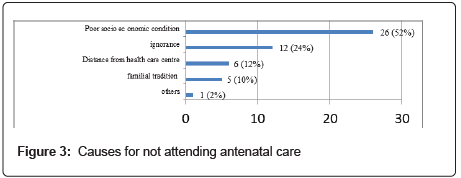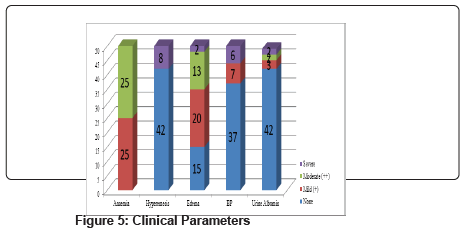Research Article, Androl Gynecol Curr Res Vol: 9 Issue: 7
Fetomaternal Outcome Of Unbooked Teenage Pregnancy, Who Delivered In A Secondary Level Hospital
S.Barkat[1], A.Z.Zinan[2],, S.Rahman[3]
Department of Gynecology, Tel No: 880171599 9491; Email: sabreena.barkatgmail.com
Abstract
Teenage pregnancy is defined as pregnancy after menarche to age of nineteen [1–3]. This period corresponds to a time when there is a gradual transition from childhood to adulthood with potential conflict between biological and social factors [1]. There is also a simultaneous physical, psychological, emotional, and social development [1, 2]. Early marriage and childbearing is still practiced in many parts of Bangladesh. Thus, more than 50% of young women in our country give birth before the age of 20 years. Contraceptive use among married teenagers is equally low because of family pressure for them to become pregnant soon after marriage [3]. The inevitable result of increased sexual activity without contraception among teenagers is unplanned pregnancy. Pregnancy at this age is at risk leads to a vicious cycle of medical, physical, and social problems from which the girl and her fetus can hardly escape [1, 4, 6] Thus such pregnancies are often complicated by hyperemesis, miscarriage, Anaemia, preeclampsia, eclampsia, and prematurity [1, 7]. Labour and delivery may also be complicated by obstructed labour leading to obstetric fistulae, instrumental delivery, caesarean section, rupture uterus, and death [1, 2]. Antenatal care provides an opportunity for pregnancy complications to be diagnosed early and appropriate intervention implied. In developed countries where pregnant teenagers receive adequate antenatal care complications are minimal [2, 8].
Keywords: Fetomaternal, Teenage Pregnancy
Introduction
Teenage pregnancy is defined as pregnancy after menarche to age of nineteen [1–3]. This period corresponds to a time when there is a gradual transition from childhood to adulthood with potential conflict between biological and social factors [1]. There is also a simultaneous physical, psychological, emotional, and social development [1,2]. Early marriage and childbearing is still practiced in many parts of Bangladesh. Thus, more than 50% of young women in our country give birth before the age of 20 years. Contraceptive use among married teenagers is equally low because of family pressure for them to become pregnant soon after marriage [3]. The inevitable result of increased sexual activity without contraception among teenagers is unplanned pregnancy. Pregnancy at this age is at risk leads to a vicious cycle of medical, physical, and social problems from which the girl and her fetus can hardly escape [1,4,6] Thus such pregnancies are often complicated by hyperemesis, miscarriage, Anaemia, preeclampsia, eclampsia, and prematurity [1,7]. Labour and delivery may also be complicated by obstructed labour leading to obstetric fistulae, instrumental delivery, caesarean section, rupture uterus, and death [1,2]. Antenatal care provides an opportunity for pregnancy complications to be diagnosed early and appropriate intervention implied. In developed countries where pregnant teenagers receive adequate antenatal care complications are minimal [2,8].
Methodology: It was a descriptive type of cross sectional study conducted in Obs and Gyn department of Monno Medical College and Hospital (indoor only), Manikganj, Dhaka over a period of 1 years (Jan 2017- Dec 2017) All pregnant women who gave consent attending Obstetric and Gynecology department (indoor) of Hospital were chosen as sample. Sample size was 50 and sampling technique was purposive. Materials used were detailed history sheet, Physical examination including P/V examination, Sphygmomanometer, Stethoscope, weighing scale, Gloves, Lubricant. The statistical analyses of collected data was performed using Special Package for Social Sciences (SPSS-V.19) computer program.
Results:
Most teenagers were in between 17 -18 years , mean age was 17.5 years
Themain cause for not attending antenatal care is poor socioeconomic condition (52%)
Figure 4: Causes of Hospital Admission
| With Complications (40%) | Without Complications (60%) | ||||
|---|---|---|---|---|---|
| Labour Pain | 13 | 26% | Hypertensive Disorders | 09 | 18% |
| Ruptured Membranes | 3 | 6% | Fetal distress | 07 | 14% |
| Abnormal Labour | 2 | 4% | Malpresentation | 06 | 12% |
| At 43 weeks | 2 | 4% | Obstructed labour | 03 | 6% |
| Total | 20 | IUGR | 03 | 6% | |
| CPD | 01 | 2% | |||
| APH | 01 | 2% | |||
| Total | 30 | ||||
Most of the patients were admitted in hospital with complications (60%)
Discussion: This study found that majority of the participants had experienced pregnancy at the age of 17-18 years, which is consistent with another study conducted in rural areas of Bangladesh, where mean age at first birth was relatively lower [5]]. The reported mean age (17.51), in the current study, indicates that still many of the marriages occur at less than 18 years of minimum legal age which may contribute to high fertility in the future as early marital pregnancy may cause a longer reproductive life among these women, provided women do not use family planning method . In this study (92%) were muslims and rest were 8%. This is because Bangladesh is a country where most of the population are Muslims. Most of the teenagers are less likely to have studied beyond primary school education (68%). Although very few studies have concentrated on education and teenage pregnancies. Nigerian study in 2001 showed that among teenage mothers 50% have studied beyond primary school [3,]. Incidence of teenage pregnancy is significantly higher among average social classes (68 %) where the monthly income is between Tk. 5000-10,000. Most of the teenagers are housewives (78 %) contributing no income in the family, thus poor socio economic condition (52%) is also responsible for not attending antenatal checkup. An African study indicated that the frequency of antenatal checkup among teenage pregnant women is poor (40%) compared to the mothers in their twenties [9] The possible reason given by the author for lower uptake of antenatal care facilities by pregnant teenagers is lack of physical and mental maturity. Study also reported that the most teenage girls were aware of at least one contraception method (86 %) and their source for such information is friends however, very few had ever used (64%) any of contraception; as a result considerable numbers of teenage mothers reported unplanned (60%) pregnancies. Almost all teenage mothers had iron deficiency, in anemia in mild (50%) or moderate (50%) form. A Bangladesh study has also shown that the prevalence of anemia is high (70%) among teenage mothers, which occurs due to low intake of dietary iron and other nutritional supplements [10] Deficiency of protein leads to hypoproteinaemia resulting in edema (70%) and thus increasing the likelihood of PIH (10%) pre-eclampsia (12 %) and eclampsia (4%). The likelihood of PIH (13%) and pre-eclampsia (5%) was significantly higher among pregnant teenagers in a Nigerian study [6,9]. Present study was conducted among hospital teenage mother who did not receive any antenatal checkup so the cause of admission were emphasized. 60% of the teenagers were admitted with complications. An African study showed that 50% of teen pregnancies were admitted with complications. [6,9].Both operative vaginal delivery and caesarean section appear to be more frequent among these patients. In this study (30%) went spontaneously into labour and delivered by assisted vaginal delivery (10%), induced vaginal delivery (01%). Majority of the patient (52%) underwent caesarian section. This higher percentage is due to lack of health education, poverty and absence of patient counseling prior to the planning of mode of delivery particularly in primigravida. The most important indication for C/S in our study was foetal distress (14 %), malpresentation (12%) Regarding perinatal outcome (96%) was born alive. Of them (48 %) needed resuscitation and still born (04 %). The cause of mortality was due to obstructed labour and eclampsia. Accordingly (68%) of newborn weighed less than 2.5 kg (32%) above 2.5 kg. APGAR score recorded in 1st mim 0-5 (76%) 6-10 (24 %) and 5th min 0-5 (12 %) 6-10 (88%).
Conclusion: In conclusion, the prevalence rate of teenage pregnancy in our community is relatively high. Majority of these mothers deliver without any form of antenatal care. These often render them vulnerable to various risks and hazards both to the mother and fetus. To reverse this trend, promotion of moral, and sex education at home, in schools, and at places of worship. Contraceptive awareness campaigns coupled with affordable and accessible family planning services for teenagers are advocated. Teenagers should also be counseled on the need for antenatal care and hospital confinement. Emergency obstetric care should be available and accessible for management of complications of teenage pregnancy. Government should empower the citizenry and encourage the education of the girl child.
References
- A. Okogbenin and E. E. Okpere. ???Age and reproductive outcome,??? inClinical Obstetrics Revised Edition 2004; 398???400
- E. Akinola, N. C. Manne, E. I. Archibong, and A. A. Sobande. Teenagers??? obstetric performance.Saudi Medical Journal 2001; 22 (7): 580???584
- D. Ekanem, S. J. Etuk, and E. I. Archibong. Socio-economic background of pregnant teenagers in Calabar, Nigeria. International Journal of Social Science and Public Policy 2001; 4(1): 235???242
- Ezimokhai, L. N. Ajabor, M. Jackson, and M. I. Izilien. Response of unmarried adolescents to contraceptive advice service in Nigeria.International Journal of Gynecology and Obstetrics 1981; 19(6): 481???485
- Madunagu and J. Akpan. Growing-up healthy! A right for all girls in women???s Health and Empowerment.Clear Lines Publications 2007; 1: 124???129
- I. Archibong. Illegal induced abortion???a continuing problem in Nigeria.International Journal of Gynecology and Obstetrics1991; 34 (3): 261???265
- Chang and D. Muran. Pediatric and adolescent gynaecology, inCurrent Obstetrics and Gynecologic Diagnosis and Treatment. International Edition 2003; 1 (9): 621
- Mayor S (2004). Pregnancy and childbirth are leading causes of death in teenage girls in developing countries. BMJ;328 (7449): 1152.
- Makinson C .The health consequences of teenage fertility. Family planning perspectives1985; 17 (3): 132???139
- Loto OM, Ezechi OC, Kalu BK, Loto A, Ezechi L, Ogunniyi SO . Poor obstetric performance of teenagers: Is it age- or quality of care-related.Journal of Obstetrics & Gynaecology2004;24 (4): 395???398







